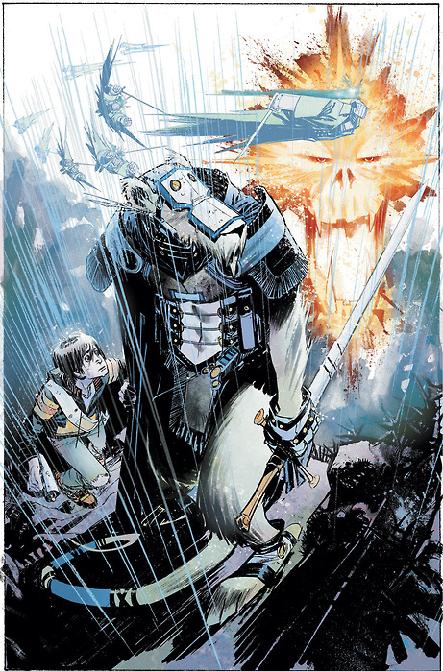Images & Words – Joe the Barbarian #2

[images & words is the comic book pick-of-the-week at OL. equal parts review and diatribe, the post highlights the most memorable/infuriating/entertaining book released that wednesday]
Joe the Barbarian is a mindfuck. A powerful, yet sweet, mindfuck that leaves the reader gasping for breath and begging for more. I have no doubt that those readers who prefer the pump-and-dump style of narrative-coitus are going to dismiss Joe the Barbarian as just another example of Grant Morrison’s insanity.
Two issues in, I’m inclined to disagree. While starting a bit slow, Joe the Barbarian definitely feels as though it’s working towards something beautiful. Sure, it’s still incredibly unclear whether the protagonist is actually engaged in a cross-dimensional journey or if he’s just hallucinating/imagining the whole ordeal (I’d guess the latter), but that’s of little consequence at this point. All that matters is that Joe is genuinely invested in his quest, thereby capturing the readers’ attention.
Fuck, I’ve done it again — I’ve somehow started reviewing a comic book without even explaining its damn premise. Hell, maybe I should’ve taken a journalism course or some shit (see: poor excuse). Or, I could just delete these three sentences, but that would somehow seem dishonest.
Anyways, this second issue of Joe the Barbarian picks up right where the first left off, with Joe seeking refuge in his childhood action figures after a rough day. How rough was this day? Well, Joe was given the impression by his mom that their house might be on the brink of foreclosure, he was bullied by a pack of goons, and he spent a bit of time brooding about his dead father. Yikes. But with the help of the action figures in his attic, Joe is transported to an alternate reality. An alternate reality that, according to these toys, Joe must save from total destruction
Throughout the second issue, Joe (referred to as “The Dying Boy” by one especially ominous action figure) begins to make his journey out of the attic and towards the rest of the house. At times, the readers are given glimpses of what Joe is really doing – this either puts his epic journey in perspective or creates a greater contrast between the world as most see it and as it is seen by the hero. Again, this makes the reader ask some important questions; did Joe really break an anthropomorphic-rat-warrior named Chakk out of jail, or did he just let his pet rat Jack out of its cage? Is Lord Arc actually an outcast who once ruled a throne of light, or is Joe talking to a lightning storm? Is Joe a chosen warrior, or is he just a hypoglycemic teen in desperate need of a candy bar?
Even if definitive answers are never delivered, the expedition from which they arise is worthwhile in its own right. Although I’m going to give writer/creator Grant Morrison his fair share of credit (yes, sometimes his madness is genius and not the other way around), I think Joe the Barbarian is truly successful because of artist Sean Murphy. As mundane and realistic as Murphy depicts Joe’s house, it’s Narnia-ified counterpart is twice as fantastic. Two-page spreads of life-size action figures in the midst of war are perfectly executed, as are skyscapes with impossible airships and stunning crescent moons. I’m not familiar with Murphy’s body of work, but his performance on Joe the Barbarian is bound to etch a place in my (admittedly depleted) brain-bank.
And although it’s a damn shame I’m putting this individual last (and am too lazy to edit this post so that he’s first), a big-ups is due to colorist Dave Stewart. As well as Murphy illustrates rat warriors and giant flaming skulls that hang ethereally, Stewart pounds on their chests and brings them to life. So while the night skies of Joe’s fantasy world evoke a sense astonishment, it is the faded purple hue that enables them to breathe and live. I really think Stewart may be outdoing his best work with Joe the Barbarian.
Joe the Barbarian #2 is just wonderful. With the interplay between fantasy and reality (ala Wizard of Oz or Chronicle of Narnia), this is a book that can be enjoyed by all ages. It’s one of those rare finds, a story that’s innocent enough for children but mature enough to entertain adults.
You’d be a fool to not give this comic a shot.



